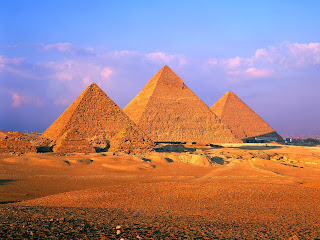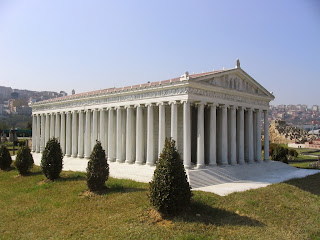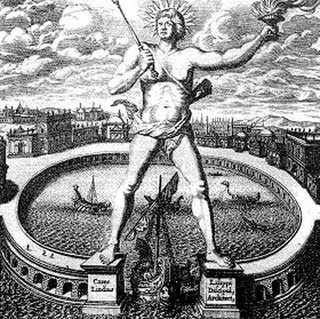The Seven Wonders of the World (or the Seven Wonders of the Ancient World) refers to remarkable constructions of classical antiquity.The Greek conquest of much of the known world in the 4th century BC gave Hellenistic travelers access to the civilizations of the Egyptians, Persians, and Babylonians. Impressed and captivated by the landmarks and marvels of the various lands, these travellers began to list what they saw to remember them. The primary accounts, coming from Hellenistic writers, also heavily influenced the places included in the wonders list. Five of the seven entries are a celebration of Greek accomplishments in the arts and architecture (the exceptions being the Pyramids of Giza and the Hanging Gardens of Babylon). Here are the list of original 7 wonders of the world.
- The Great Pyramid of Giza:
The Great Pyramid in Egypt is a giant tomb.It was built from about 6.5 million tonnes of stone some time between 2575 B.C. and 2465 B.C. The pyramid was the burial place of the Pharaoh Khufu. Many people around the world built burial tombs, but the largest were built by the Egyptians. It is the only original wonder still in existence. It is believed that archaeologists have discovered living quarters for about 4,000 specialist workers near the Great Pyramid. It is also said that, it took about 10,000 workers over 20 years to built the Pyramid.
- The Hanging Gardens of Babylon: Babylon was situated near the present-day city of Al Hillah, Iraq. The most famous of the kings of Babylon., King Nebuchadnezzar II, rebuilt the capital city of Babylon when he came to power in 605 B.C. He created the beautiful terraced gardens for his Persian wife, who missed her tree-and mountain-covered homeland. Hanging gardens were so called because they grew on the roofs of high buildings. The plants' branches and leaves hung over the walls. Legend has it that this garden paradise was planted on an artificial mountain, but many experts say it never really existed. However, whose location has not been definitely established, it is said that Babylon was destructed due to huge earthquake in around 1st century B.C.
- Temple of Artemis at Ephesus: The Temple of Artemis also known less precisely as the Temple of Diana, was a Greek temple dedicated to the goddess Artemis, the Greek goddess of the hunt ,and was one of the Seven Wonders of the Ancient World. It was located in Ephesus and was completely rebuilt three times before its eventual destruction in 401.Only foundations and sculptural fragments of the latest of the temples at the site remain.The first sanctuary (temenos) antedated the Ionic immigration by many years, and dates to the Bronze Age. Callimachus, in his Hymn to Artemis, attributed it to the Amazons. In the 7th century BC, the old temple was destroyed by a flood. Its reconstruction began around 550 BC, under the Cretan architect Chersiphron and his son Metagenes, at the expense of Croesus of Lydia: the project took 10 years to complete, only to be destroyed in an act of arson by Herostratus. It was later rebuilt.However, the main reason of destruction of the original structure of 550 B.C was Arson by Herostratus, (plundering) on 356 B.C and rebuilt structure of 323 B.C was destructed by the Goths on 262 A.D.--(source: mostly Wikipedia)
- Statue of Zeus: The Sculptor Phidias made a huge statue of the Ancient Greek god Zeus in about 435 B.C. One of the largest indoor sculptures ever made, it was carved out wood and covered with gold and ivory. It stood in the temple to Zeus at Olympia, Greece.It was regarded as one of the Seven Wonders of the Ancient World until its eventual loss and destruction during the fifth century AD. No copy of the statue has ever been found, and details of its form are known only from ancient Greek descriptions and representations on coins. The temple of the Zeus was built during 466 B.C - 456 B.C. and was disassembled around 5 - 6 A.D by .. The statue of the Zeus was built during 435 B.C and was destructed by fire.
- Mausoleum at Halicarnassus:
The Mausoleum at Halicarnassus or Tomb of Mausolus was a tomb built between 353 and 350 BC at Halicarnassus (present Bodrum, Turkey) for Mausolus, a satrap in the Persian Empire, and Artemisia II of Caria, who was both his wife and his sister. The structure was designed by the Greek architects Satyros and Pythius of Priene.The Mausoleum was approximately 45 m (148 ft) in height, and the four sides were adorned with sculptural reliefs, each created by one of four Greek sculptors — Leochares, Bryaxis, Scopas of Paros and Timotheus. The finished structure of the mausoleum was considered to be such an aesthetic triumph that Antipater of Sidon identified it as one of his Seven Wonders of the Ancient World. Carians were the formal builder of the Mausoleum, built around 351 B.C and was eventually destructed by 1494 A.D. but huge earthquake.
- Colossus of Rhodes: The Colossus of Rhodes was a statue of the Greek Titan Helios, erected in the city of Rhodes, on the Greek island of the same name, by Chares of Lindos in 280 BC. It is considered one of the Seven Wonders of the Ancient World. It was constructed to celebrate Rhodes' victory over the ruler of Cyprus, Antigonus I Monophthalmus, whose son unsuccessfully besieged Rhodes in 305 BC. The Colossus of Rhodes stood over 30 meters (98.4 ft) high, making it one of the tallest statues of the ancient world. The statue was built with an iron frame work. Over this they used brass plates to create the skin and outer structure of Helios. It was reported that it took approximately 900 camels to carry away all the scrap metal.The design, posture and dimensions of the Statue of Liberty in New York Harbor are based on what the Colossus was thought by engineers in the late 19th century to have looked like.Both the Colossus of Rhodes and the Statue of Liberty were built as symbols to freedom. The date of construction began from 292 - 280 B.C. by the Greek builders. The Colossus of Rhodes was destroyed in an earthquake in 226 BC, but pieces of the statue lay where it fell for centuries afterwards. Ptolemy III, the king of Egypt offered to pay for the Colossus' reconstruction. The Rhodians refused. They believed that Helios himself was angered by the statue and caused the earthquake that destroyed it.The Rhodians were conquered by the Arabs in the 7th century A.D. The Arabs dismantled what was left of the Colossus and sold it as scrap metal.(source: Wikipedia)
- Lighthouse of Alexandria: The lighthouse on the island of Pharos, at the entrance to Alexandria harbor, in Egypt, was huge- probably 150 m (500 ft) high. It was competed in 270 B.C. and destroyed in A.D. 1302. At its top was a fire beacon to guide ship, and below were look-out points. It took 12 years to complete, at a total cost of 800 talents, and served as a prototype for all later lighthousesin the world. The light was produced by a furnace at the top and the tower was said to have been built mostly with solid blocks of limestone. Strabo reported that Sostratus had a dedication inscribed in metal letters to the "Saviour Gods". Badly damaged by three earthquakes between 956 and 1323, it then became an abandoned ruin. It was the third longest surviving ancient wonder (after the Mausoleum at Halicarnassus and the still extant Great Pyramid of Giza) until in 1480 the last of its remnant stones were used to build the Citadel of Qaitbay on the site.
The seven wonders on Antipater's list won praises for their notable features, ranging from superlatives of the highest or largest of their types, to the artistry with which they were executed. Their architectural and artistic features were imitated throughout the Hellenistic world and beyond.






